Enjoy now the fourth, and final, chapter
“How silver changed the world”
In the last chapter of this special series, learn about how the dollar became a global currency and how the Chinese culture influenced Europe


A galleon destined for Acapulco is jam-packed with goods, mostly from Chinese merchants, which are loaded right up until the moment of departure. Onboard, passengers from all over the world eagerly await weighing anchor
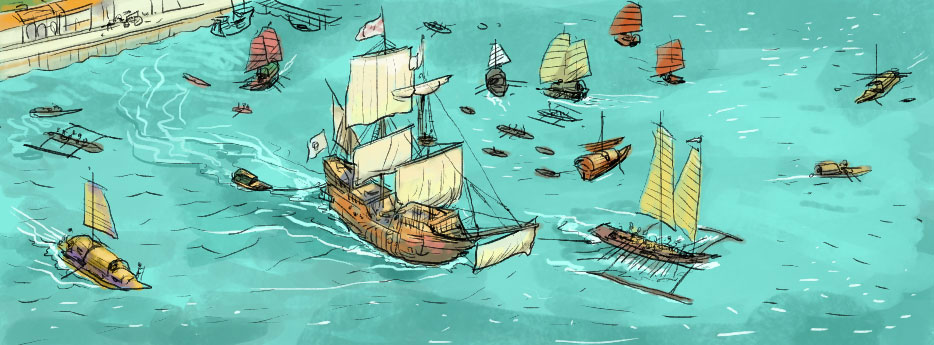
The galleon sets sail before noon. A parao tows the galleon out of port and will help direct the larger ship to the Pacific Ocean
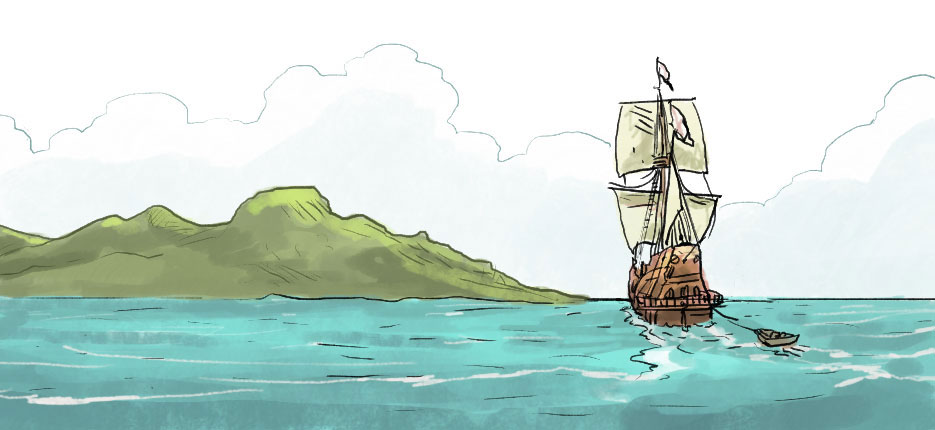
This visual narrative takes its inspiration from the eyewitness account of Giovanni Francesco Gemelli Careri. The seventeenth-century Italian adventurer’s journal provides a colourful record of his voyage from the Philippines to Acapulco
May 20, 2018

By Adolfo
Arranz

Marco
Hernandez
The voyage from the Philippine Islands to America, may be called the longest, and most dreadful of any in the world, because of the vast ocean to be crossed, being almost the one half of the Terraqueous globe, with the wind always a-head, as for the terrible tempests that happen there, one upon the back of another, and for the desperate diseases that seize people in 7 to 8 months, lying at sea sometimes near the line, sometimes cold, sometimes temperate, sometimes hot, which is enough to destroy a man of steel, much more flesh and blood, which at sea had but indifferent food”
Giovanni Francesco Gemelli Careri, 1698
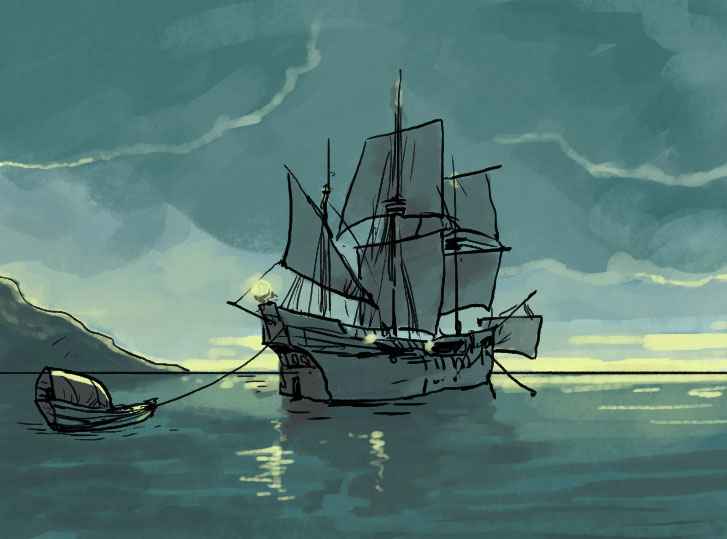
A lack of wind makes for painfully slow progress. After several days the galleon has barely travelled three leagues* from Manila. Any wind that does blow, tends to send them off course
* 13 nautical miles, about 24km
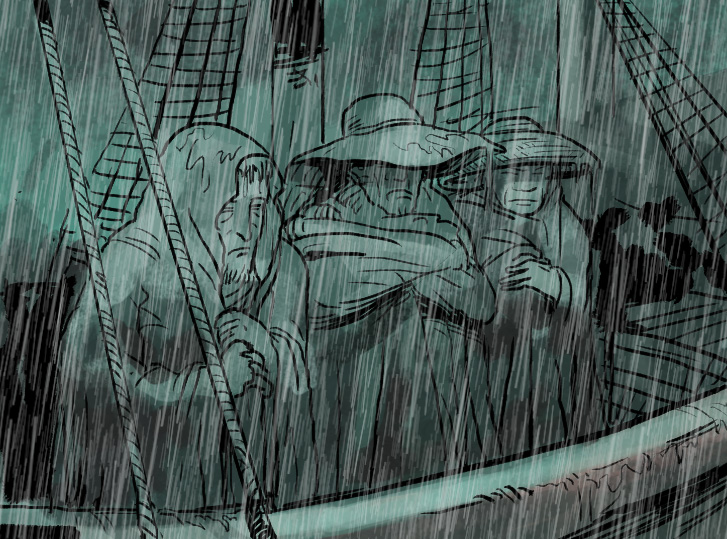
It is hot, wet and still. The vessel remains stuck in the bay for several days

The trip is barely under way when the crew and passengers begin to experience inclement weather

In the absence of favourable winds they are forced to tow the galleon for the next three days
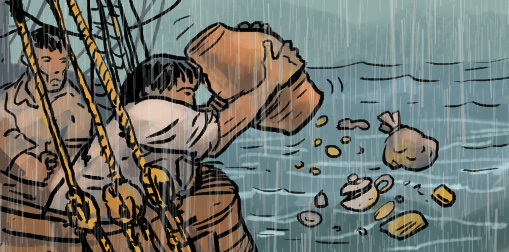
Meanwhile, a search for contraband reveals many of the ship’s freshwater jars have been instead filled with merchandise. The captain orders the commodities, which consist of pepper, porcelain, and other valuables, to be thrown overboard

Winds blow against the ship and wipe out the progress of the previous days
After 17 days, the crew must navigate treacherous waters when two opposing currents come together. The galleon has only managed to travel about 98 nautical miles
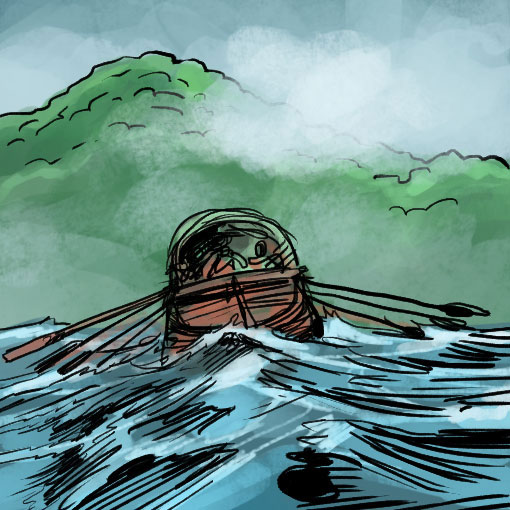
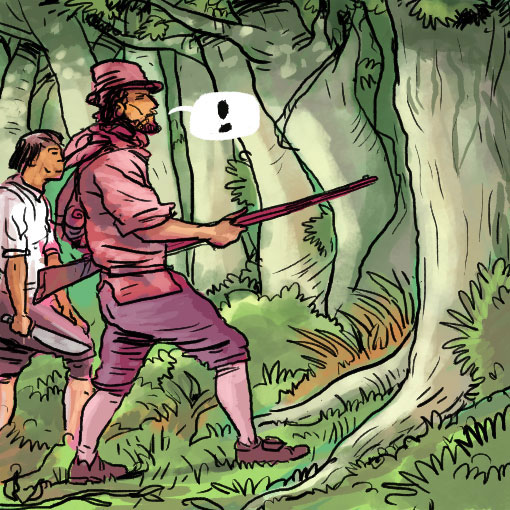
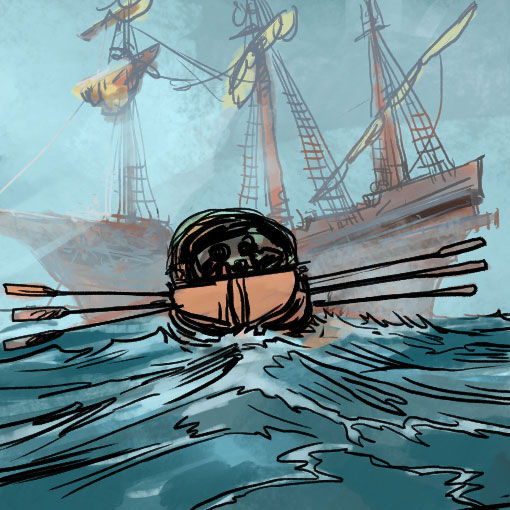
As soon as there is a break in the weather, some crew, and passengers, form a hunting party. They take a sampan to Marinduque Island in the hope of finding some deer or buffalo. The hunters can’t find any prey along the shore either and return to the galleon empty-handed. Once on the island, the party can barely make any headway through the dense forest

Finally, a fresh southerly gale blows in. The galleon weighs anchor and leaves the Marinduque and Banton islands in itswake
-turn up the volume and slowly scroll down-
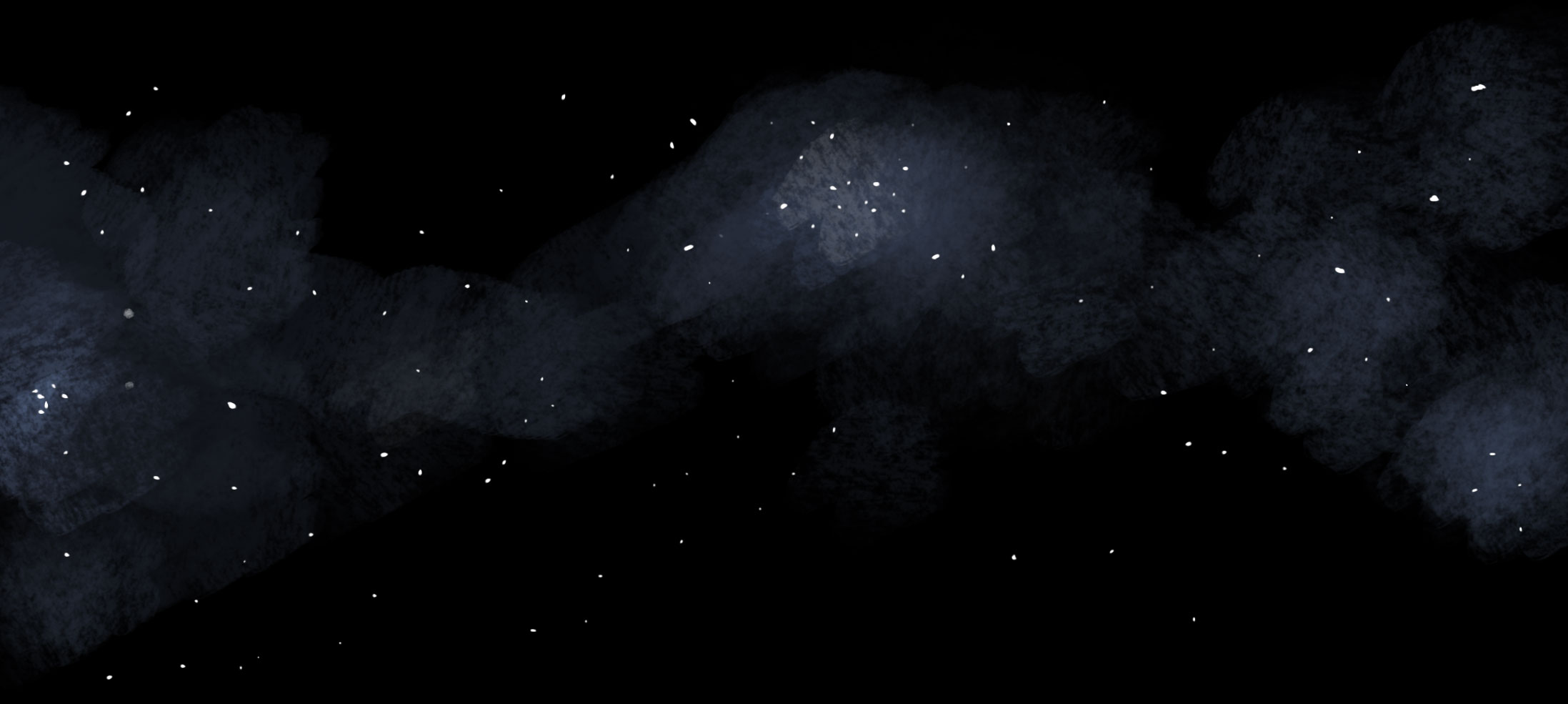

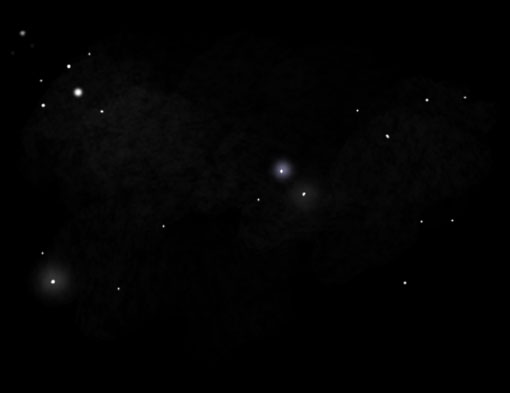

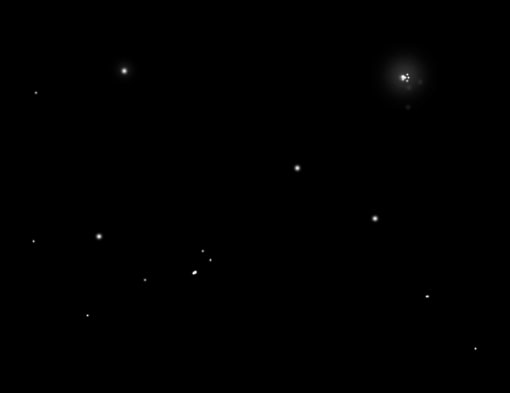

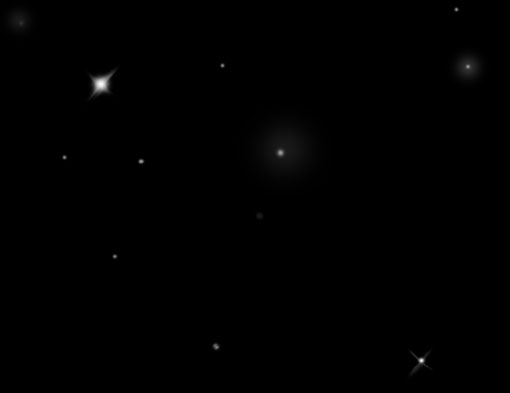

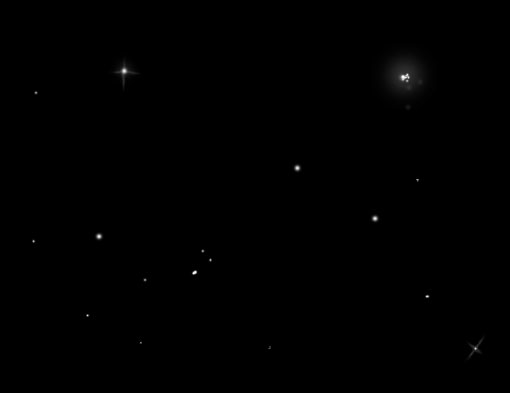




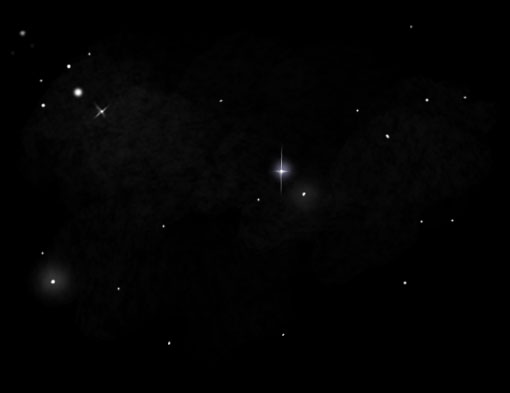

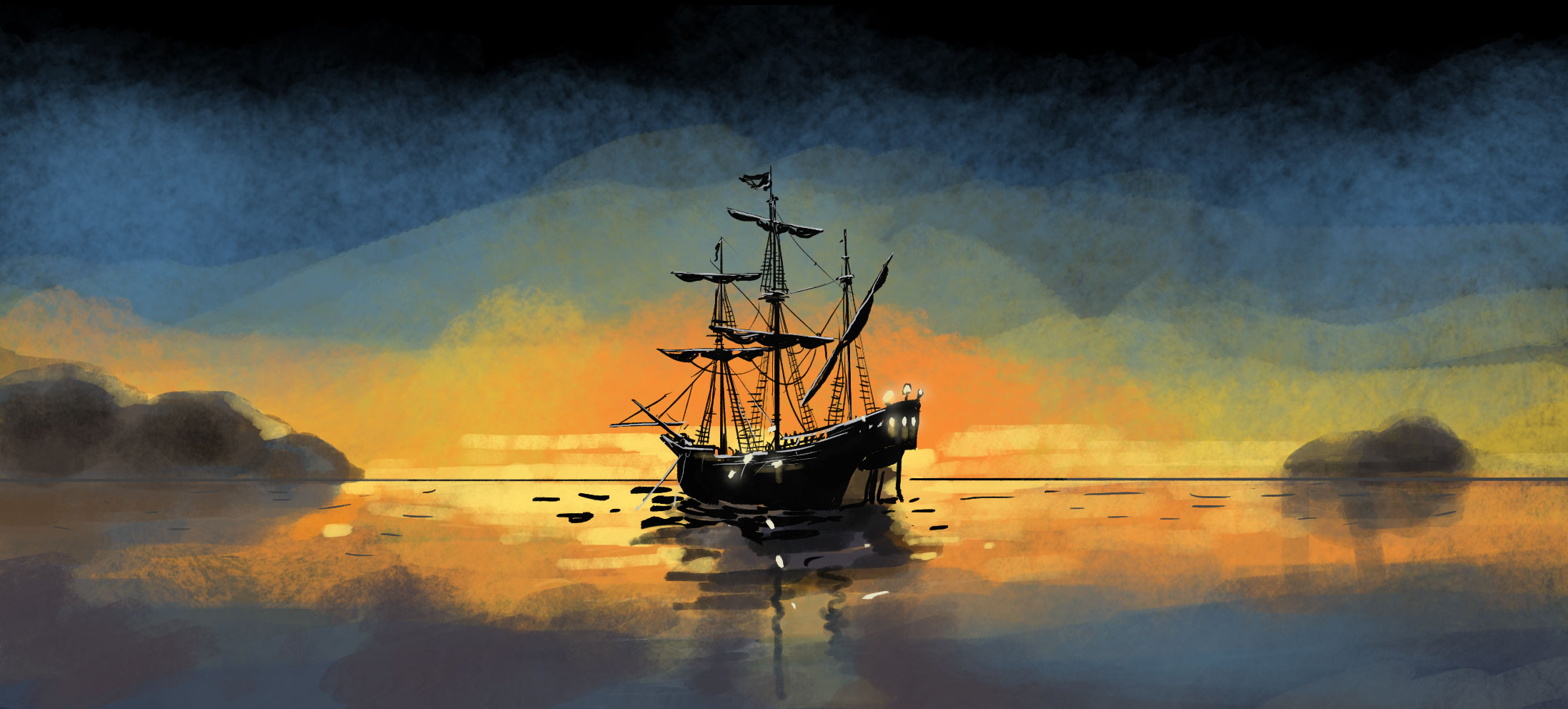
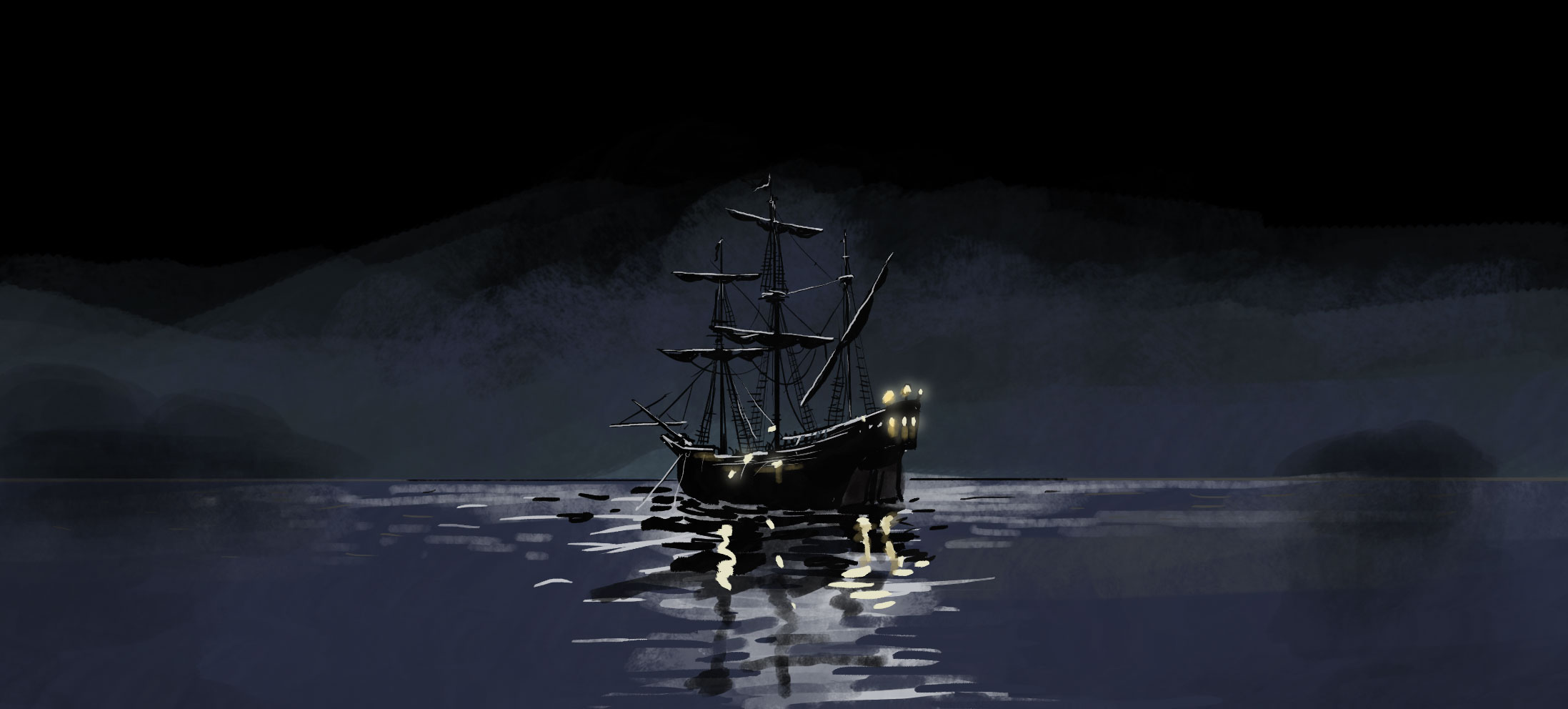


The journey through the embouchure of San Bernardino becomes very slow. The galleon has to cast anchor at night because there is insufficient light from the stars for the pilot to manoeuvre through the tangle of islets and reefs
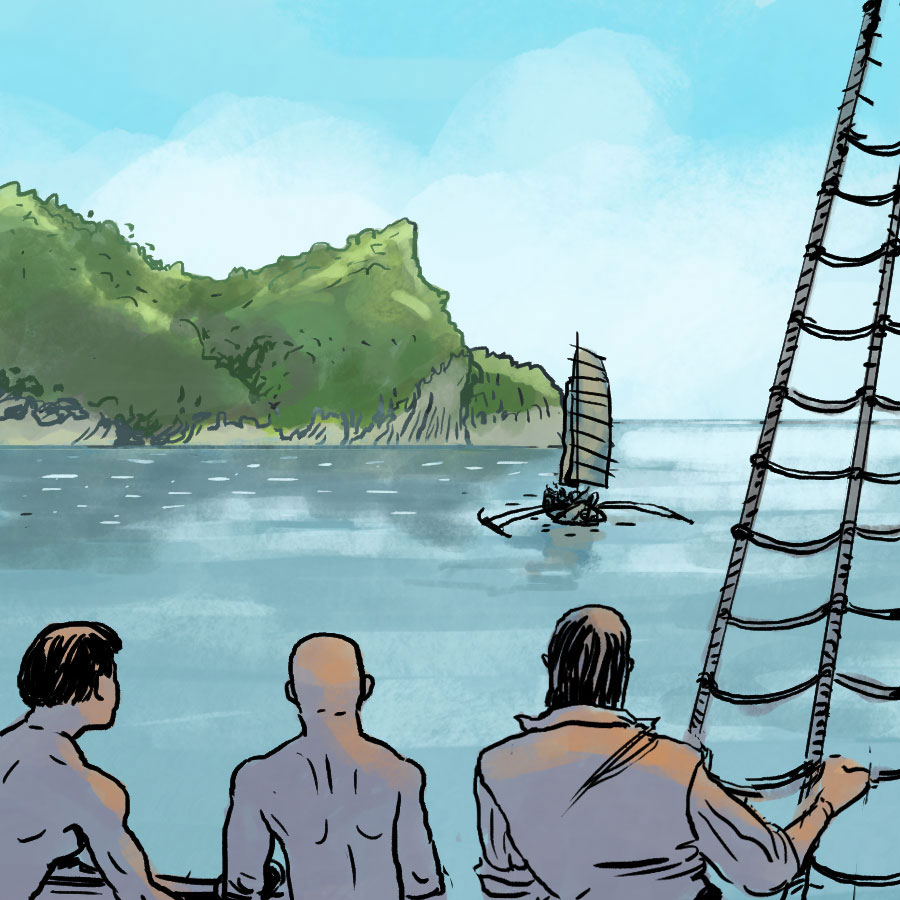
At last, the galleon reaches the shores of Ticao Island. The crew and passengers become excited when a caracoa approaches
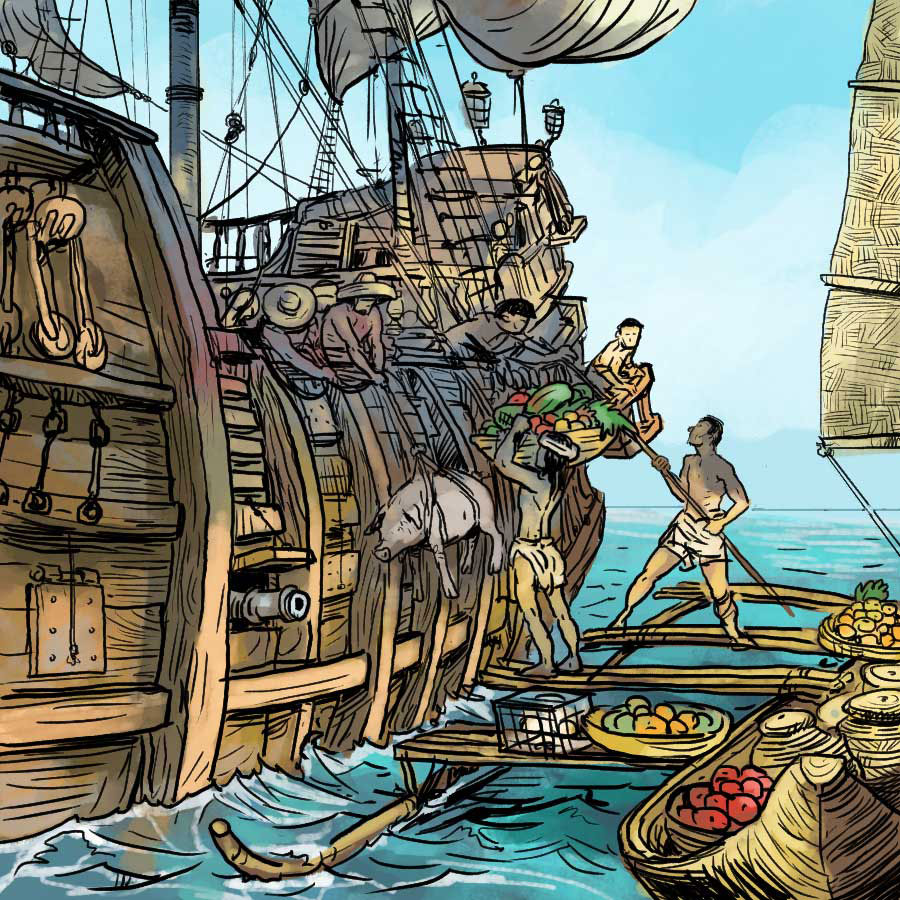
The caracoa delivers fresh vegetables and fruit, as well as livestock in the form of pigs and chickens. The goods are a gift from the chief magistrate of Albay province
The travellers can barely believe their eyes when they take the floating garden, abundant with fruit and vegetables, aboard their ship
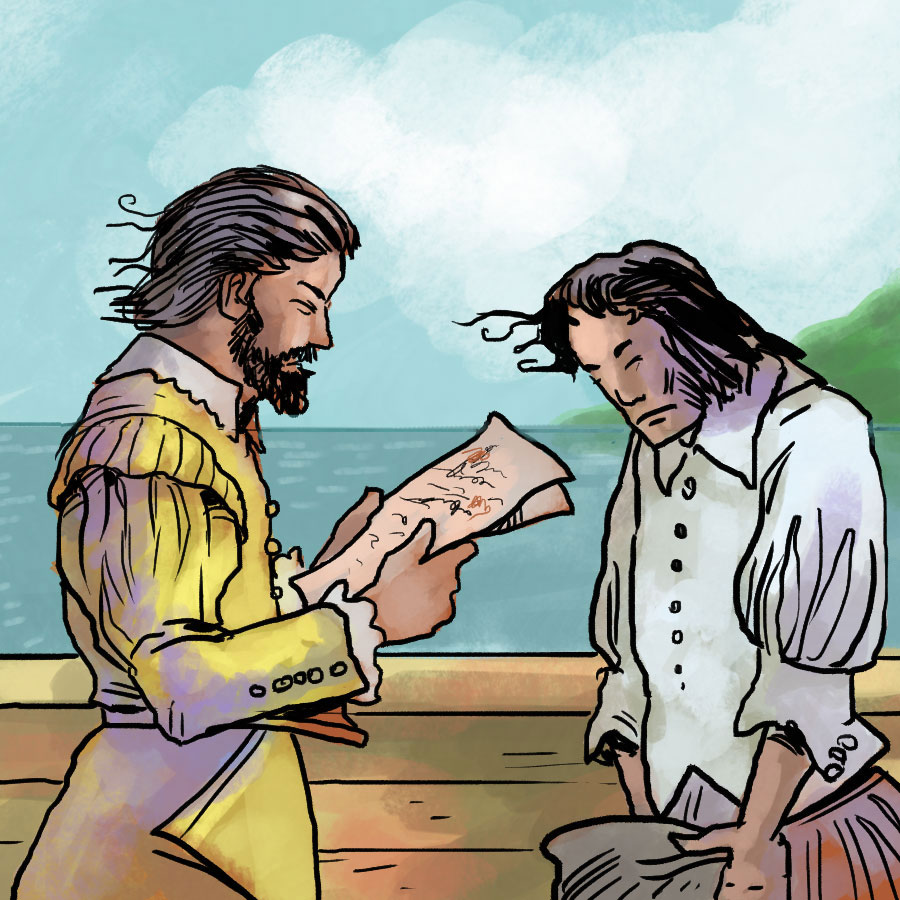
Meanwhile, with the ship still at anchor, an inspection is carried out for anyone travelling without a licence. Licences cost 20 pieces of eight and are payable to the King of Spain
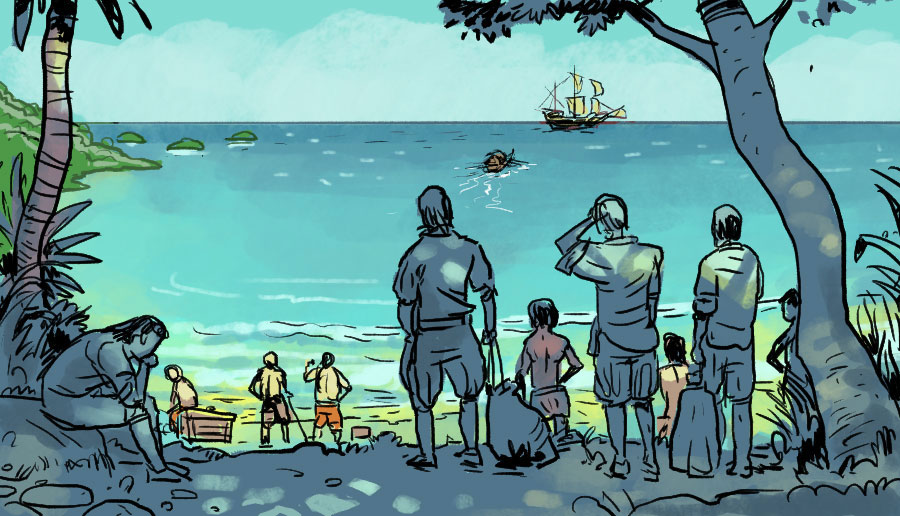
Sixteen people are found without the correct paperwork and sent ashore, where they are left stranded
It is now over a month since the ship left Manila. But, after a painful beginning, the galleon finally approaches the embocadero – the entry point to the Pacific Ocean
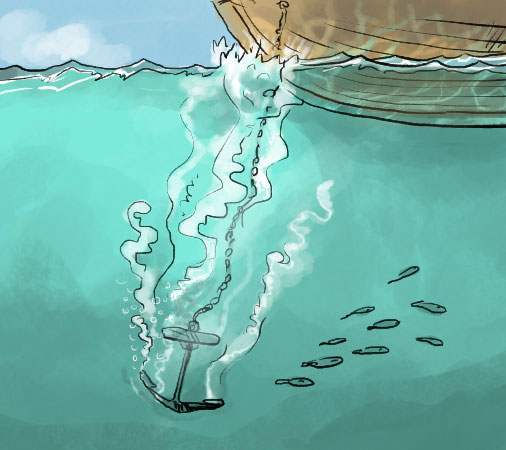
However, after the galleon advances a few miles, unfavourable winds again force the crew to drop anchor. They remain stuck several days
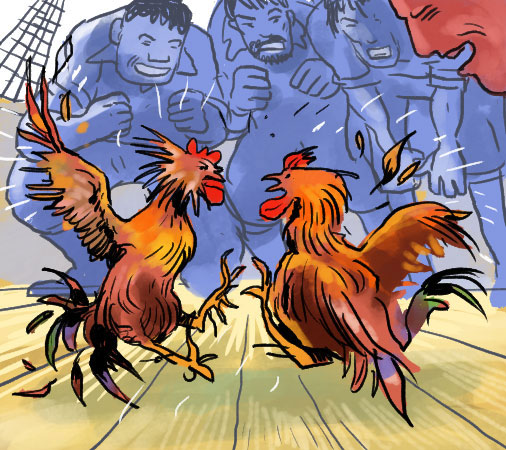
With poultry still abundant at this stage of the journey, passengers and crew divert the tedium by holding cock-fighting contests. It will still be a while before the fowl are needed for the cooking pot
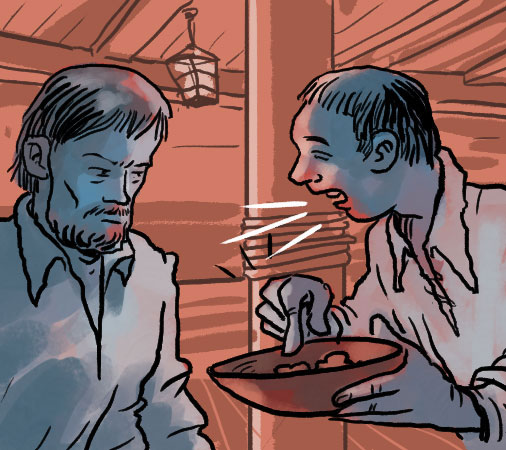


Nerves begin to strain. When a passenger complains that he is poorly fed the pilot’s mate strikes him in the face. Infuriated, the passenger threatens him with a knife and chases him around the ship to exact revenge
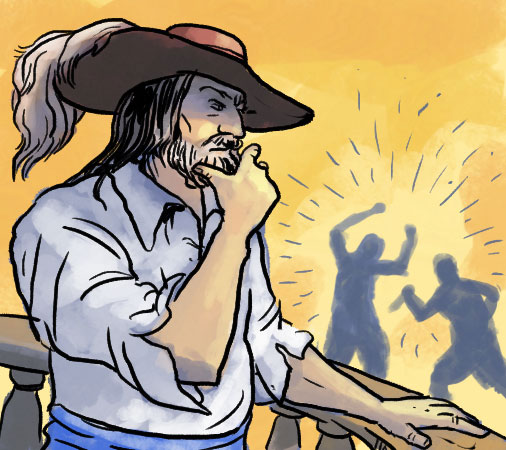
The captain stops the fight and decides to take action by punishing both men

Their punishment is to stand on deck, in the blazing sun, clapped in iron shackles, called bilboes
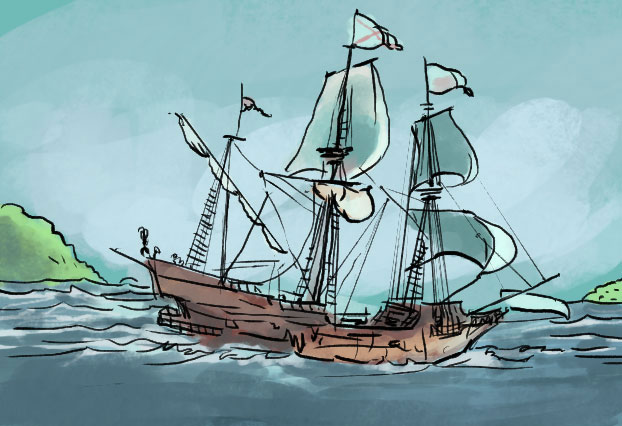
Favourable winds finally gather and the pilots seize the opportunity to weigh anchor. They head straight for the embocadero to gain entry to the Pacific Ocean. The currents in the San Bernardino Strait are always hazardous, making the outward passage to America extremely dangerous
A violent storm strikes that night. The motion of the sea is like water boiling on a stove and, as the rain lashes down, the passengers tremble with fear throughout the night, knowing they are in grave danger. The contrary winds check the ship’s advance
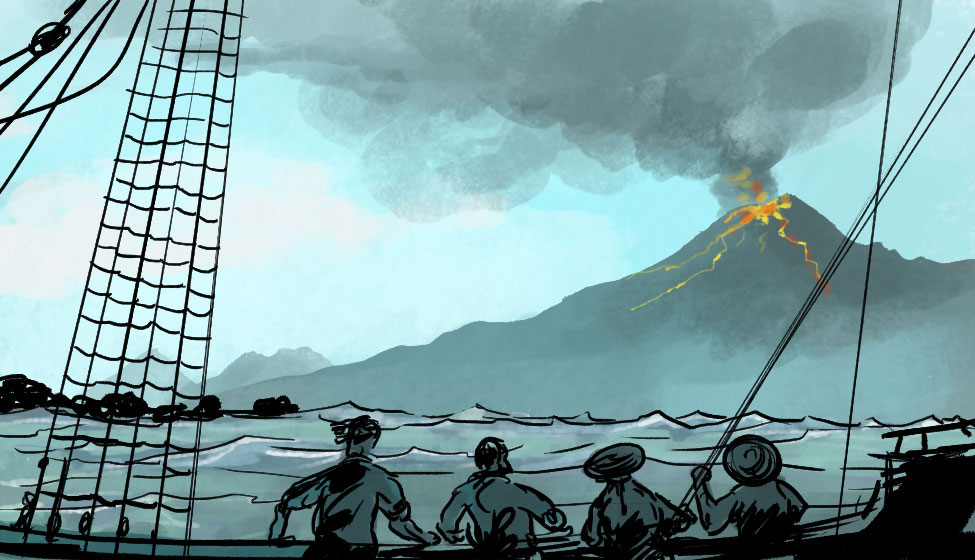
That morning, the currents and tide become more favourable and the boat can sail through the strait. From the ship, the sailors watch the Albay volcano* erupt in the distance
(*) Now called the Bulusan volcano
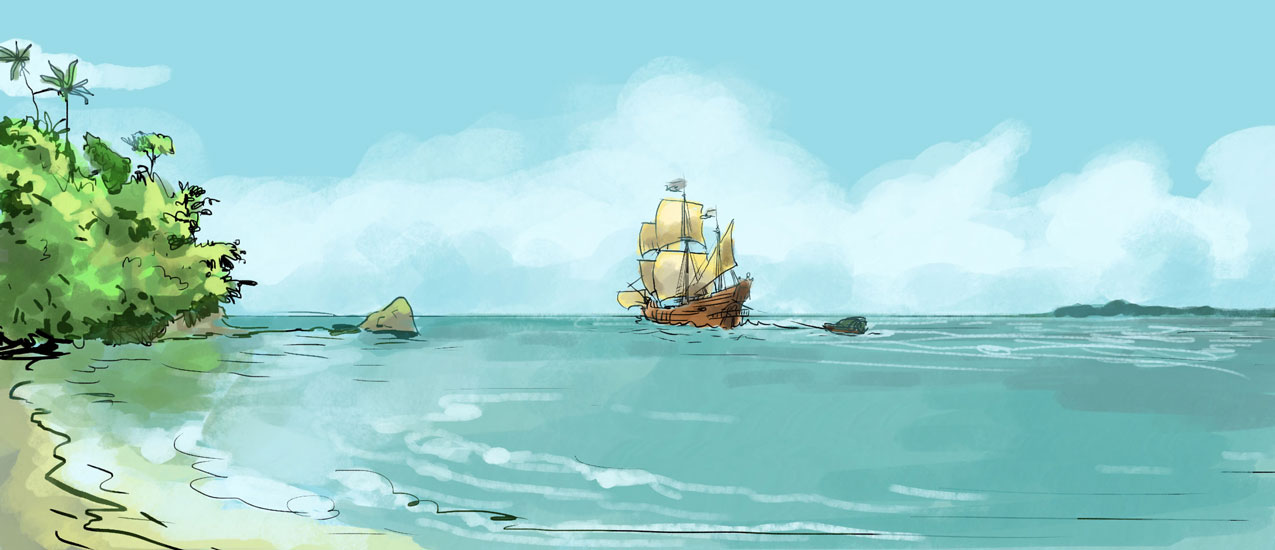
To the great relief of all onboard, the galleon enters the open sea through the San Bernardino Strait. A long journey across the Pacific to the Americas lies ahead

All cables are stowed below decks; there will be no need to cast anchor until they reach New Spain

The sampan is set adrift to avoid becoming a hindrance. There is another boat on board in case of emergency
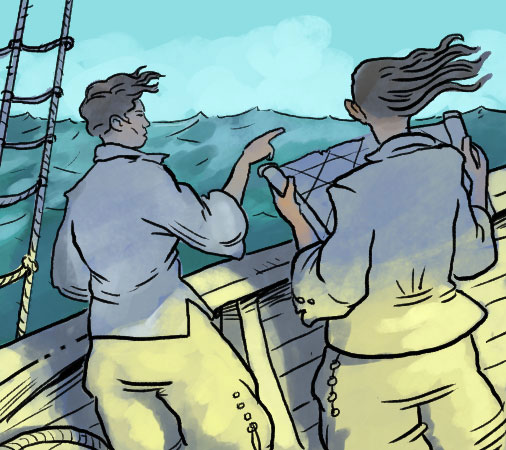
The pilots choose to set course for the Mariana Islands before taking the northwest route. The conventional voyage to New Spain does not include passing the islands

The water allowance is restricted after two weeks. The expedition has made little progress towards their destination
Location of the galleon after 66 days at sea
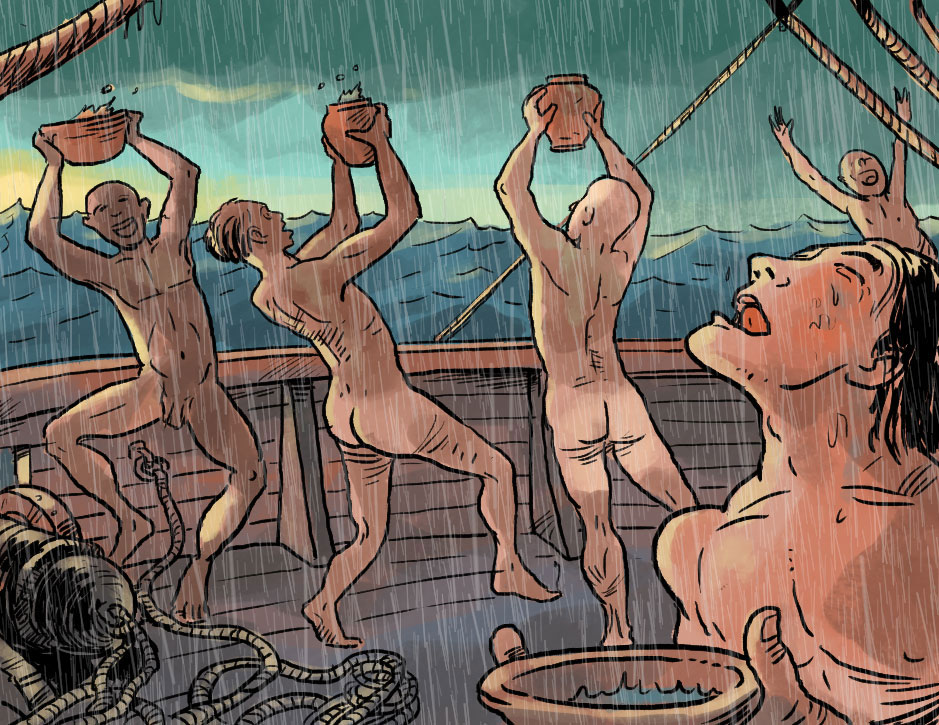
At sunset, there is a sudden deluge of rain. The thirsty sailors celebrate by dancing naked in the rain and fill their empty vessels. The rain continues all night and they store plenty of water

However, the rains turn into a ferocious storm - furious winds and waves break over the galleon’s deck. The pilots are obliged to lower their topmast for fear it will break and endanger the voyage

While huddled under the mainsail the sailors share a vision of Saint Francis Xavier. Three hours before daybreak the winds turn fair. The captain vows to donate 200 pieces of eight – the value of the sail – as a devout offering to the saint’s intercession
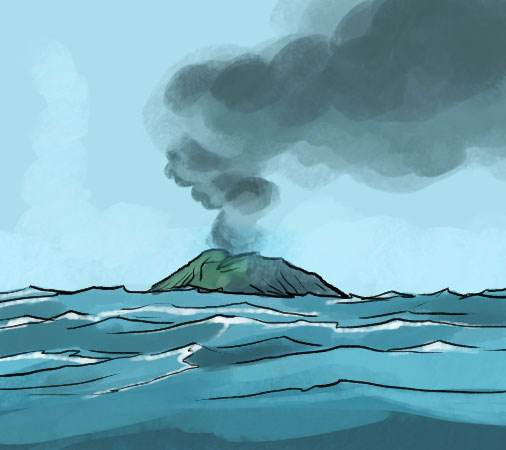
On Thursday September 6, the Mariana Islands take shape in the distance, but unfavourable winds prevent the pilot from navigating to a latitude of N 19° as he had planned. They sight one of the islands, called Griga,* billowing smoke in the distance
(*) Agrihan
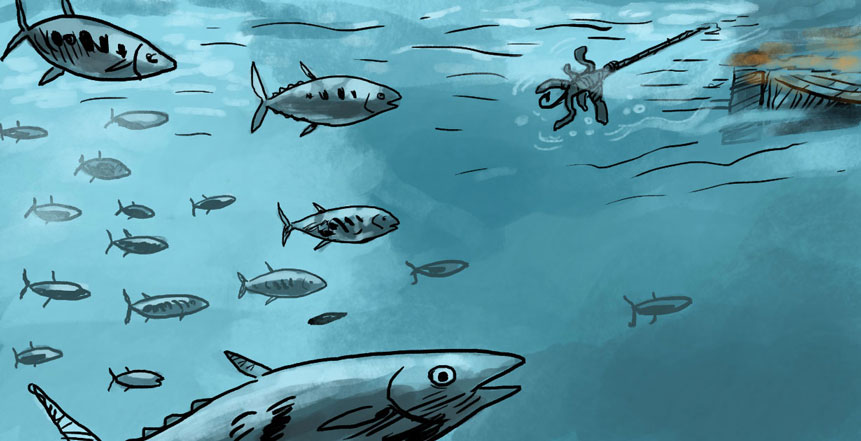
The crew catch scores of cachorretas*, using rags, made to look like flying fish, as bait
(*) Skipjack tuna
On September 9, the sky turns a lurid violet, and green clouds appear. Having never seen the like before, the travellers take it to be a good omen. The pilot begins devotions for securing a safe voyage. That night they all dance and pray in thanks
(Although uncommon at latitude N 21°, it is thought the ship witnessed an Aurora Borealis. One was recorded on a similar latitude in 1859 in Hawaii)
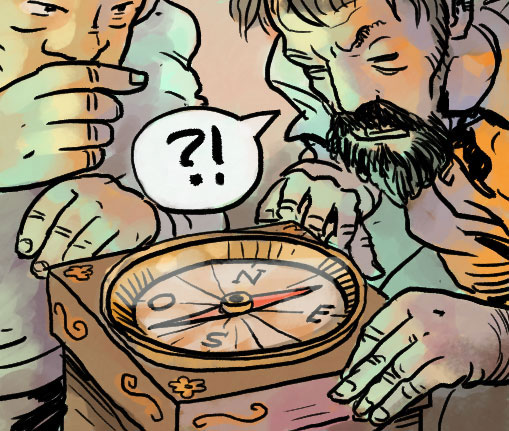
Other seemingly mystical events happened after they left the San Bernardino Strait, when pilots often discovered their compass needle would not point to the North Pole
(*) The anomaly occured when the vessel passed over an area of seabed now known to be composed of volcanic rock, which contains large amounts of the mineral magnetite. Magnetite disrupts compass readings
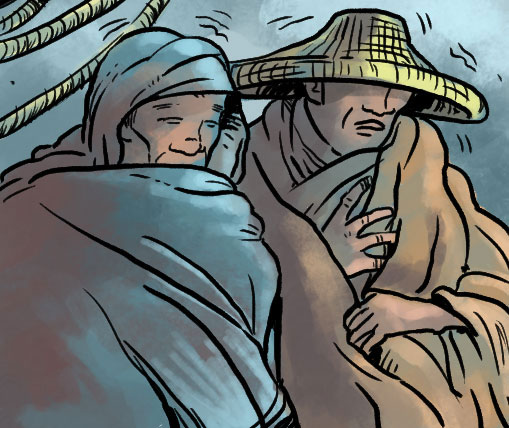
Twenty days later, with auspicious winds occasionally at their back, they reach latitude N30°. The crew receive blankets and appropriate clothing as the climate takes an abrupt cold turn. The food rations are beginning to dwindle
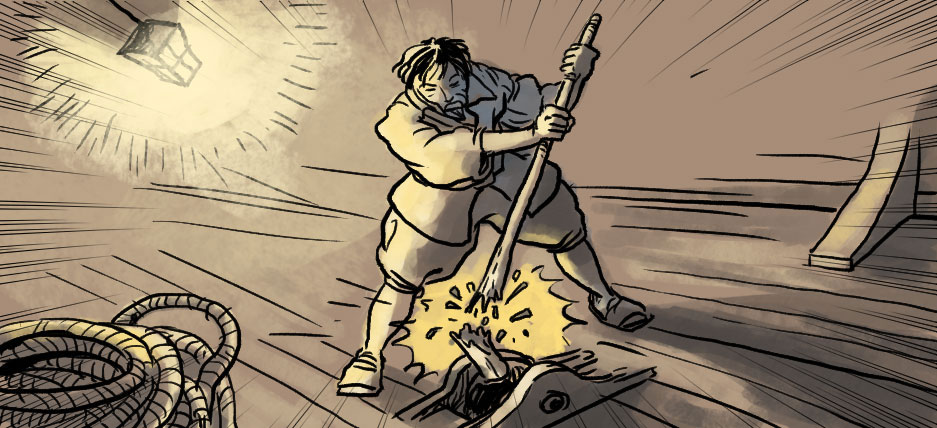
A great storm blows on the second day of October. With the sea beating against the galleon they are forced to lie the foresail back. Waves beat the rudder furiously, breaking the whipstaff*. At 33°N, the storm increases, refusing to abate
(*) see Chapter 2
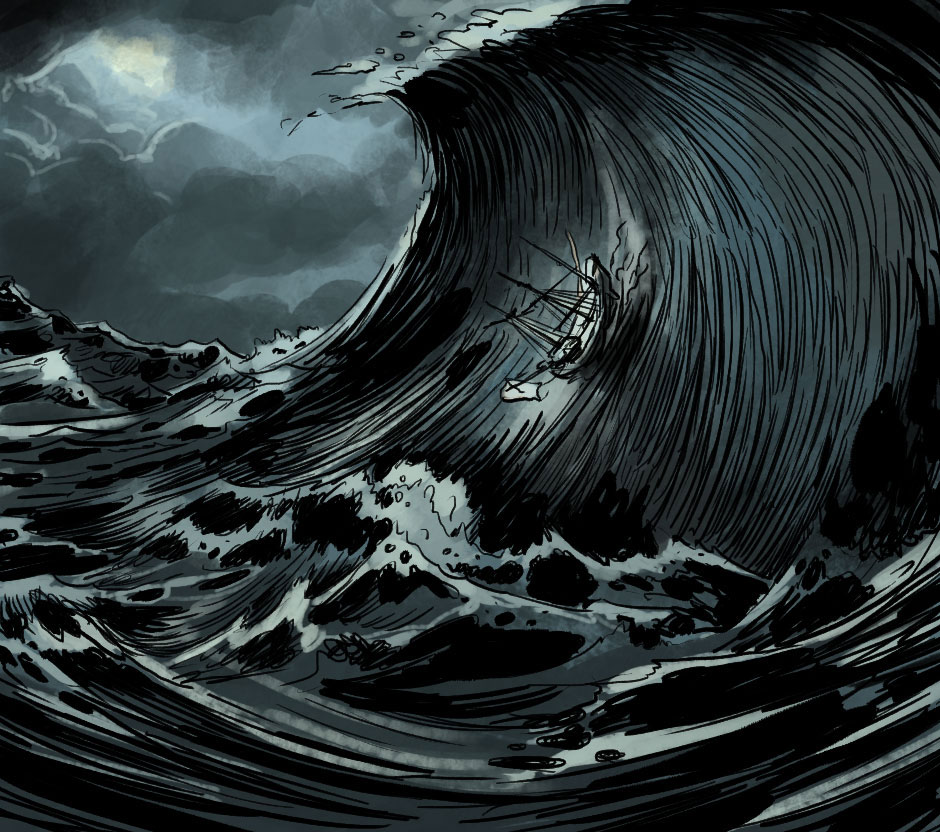
The ship is tossed about like matchwood atop vast mountains of water. The passengers feel they are sinking into the abyss everytime water breaks over the ship
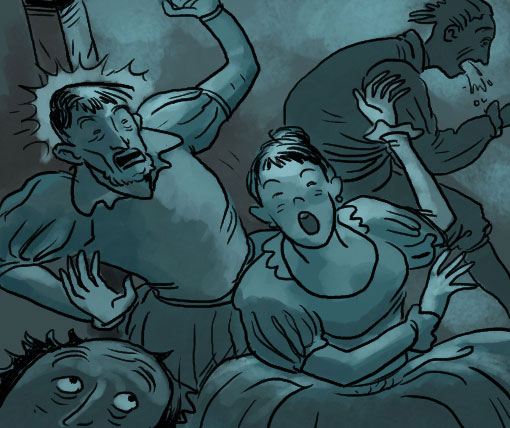
People are thrown violently from side to side of the ship, and struck by objects flying around
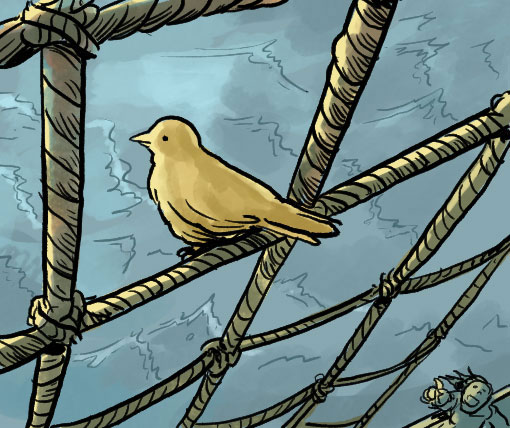
The next day the storm continues, but eventually begins to ease. A small bird, possibly a canary, lands in the rigging, apparently blown onto the boat by the wind. It quickly ends up in the belly of the pilot and his assistant. Meanwhile, the passengers fantasize about some nearby islands
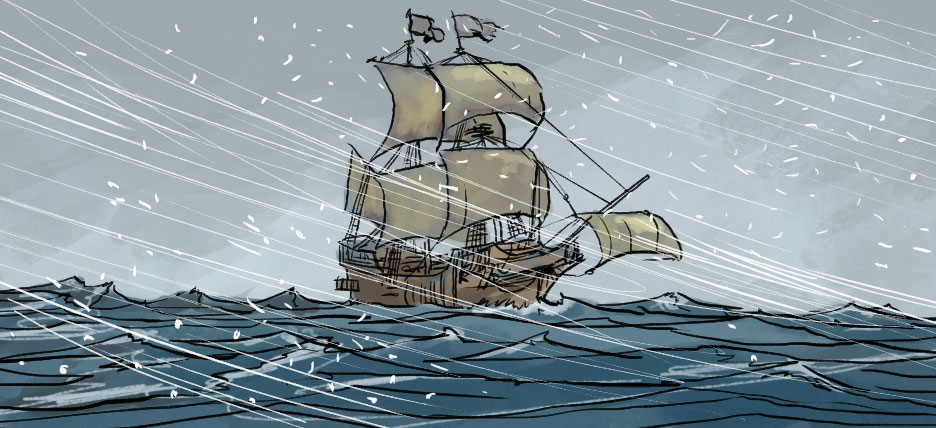
They reach latitude 36°N. The weather becomes crisp
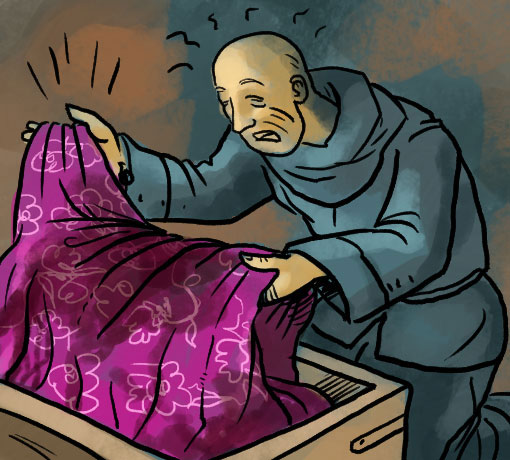
Storms and heavy rains ruin several bunkers of silks and fabrics from China. A catastrophe for one owner, who sees his business completely ruined
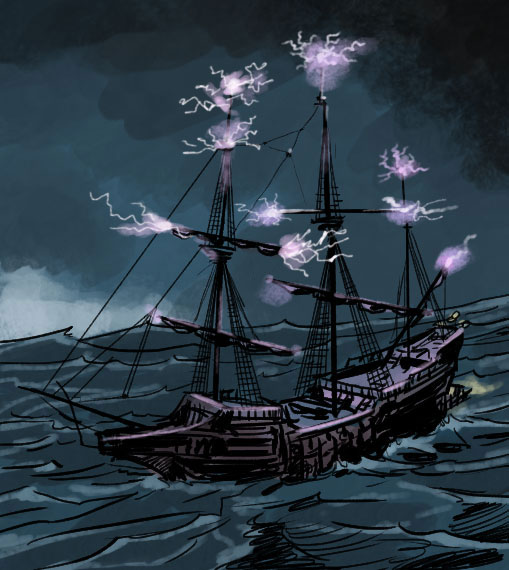
The galleon now sets a course of east-southeast. Finally, rain storms give way to calm seas. At night a light appears which the sailors refer to as Saint Elmo’s fire. It is saluted by passengers and crew alike – Spaniards considered these incidents to be good omens sent by God. Saint Elmo’s fire appears several times during the voyage
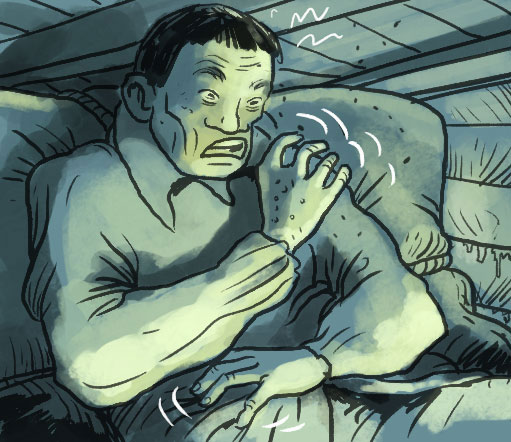
As well as the cold, being hurled about and struck by debris during storms, the passengers also experience famine, illness and other hardships. For instance, the galleon becomes full of gnats sucking the passengers’ blood. There are also weevils, which swarm into the bread and biscuits
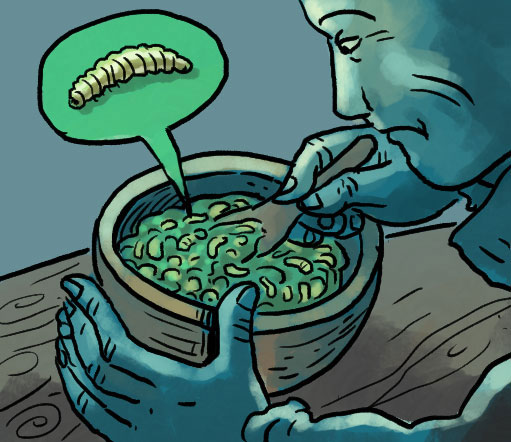
Their diet now consists of soup made from mung beans which are full of maggots that float to the top of the broth

Other times they have tasajos, steaks of beef, or buffalo, dried in the sun or wind. These are tough to digest, and impossible to chew, without first beating and pounding the meat vigorously
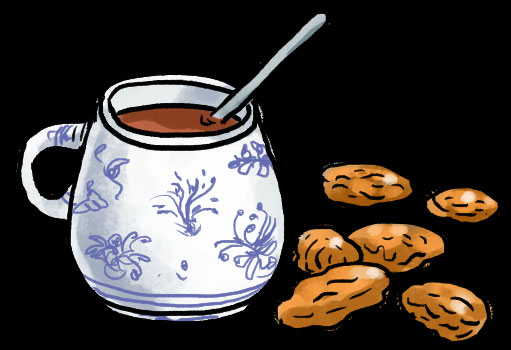
Still, there is chocolate twice a day, and at dinner they sometimes have sweetmeats. When food supplies run short, the sweetmeats are placed in custody, and held back for the sick
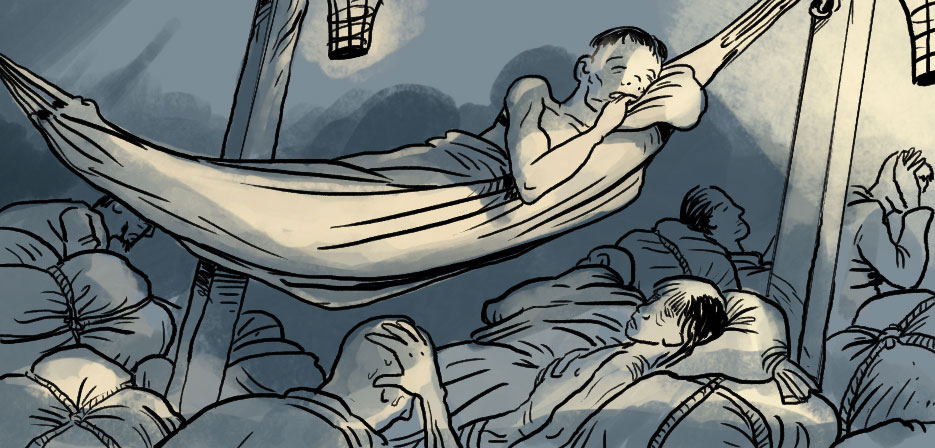
Being exposed to the elements, the continual rain, cold and other hardships of the season, and without access to biscuits, rice, or fowl the sailors begin to fall sick
All on board rejoice when a dove is seen flying overhead. After the recent hardships, this is taken as a new omen that the voyage will be successful. They hope to sight land within the month
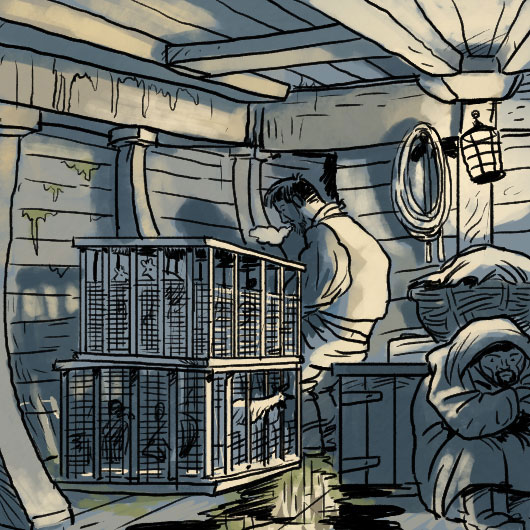
By November 19, they have reached latitude 39°N. Intense cold and humidity permeates the boat, forcing some passengers to take refuge in the poultry coop. At night, they refuse to go outside to relieve themselves, fouling the areas below deck instead. The next morning, the air is filled with colourful complaints from the crew
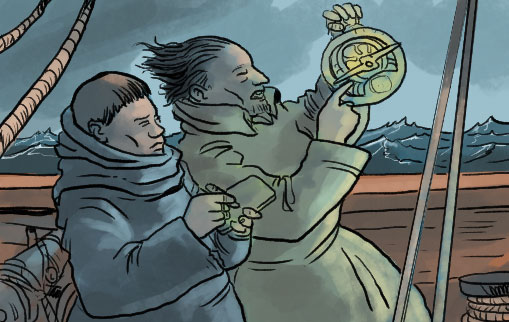
The pilots conduct daily observations throughout the voyage to determine the vessel’s location on their charts
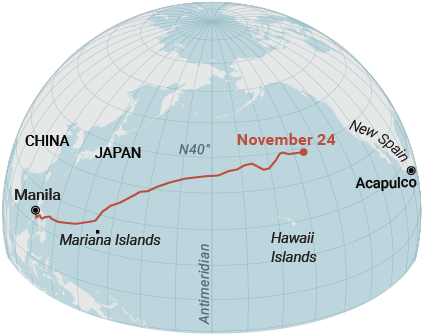
This was the ship's location on November 24, 5,700 nautical miles since leaving Manila port
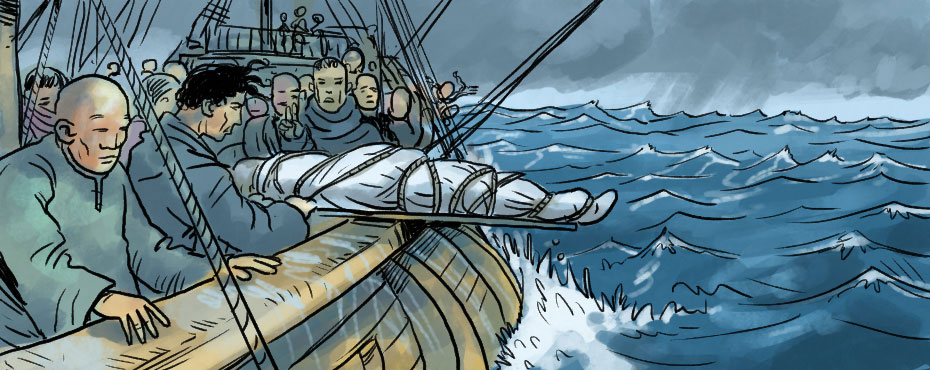
A sailor dies from scurvy. He is the first fatality after 156 days at sea. His body is thrown overboard with an earthen vessel tied to his feet. Passengers and crew are filled with despair

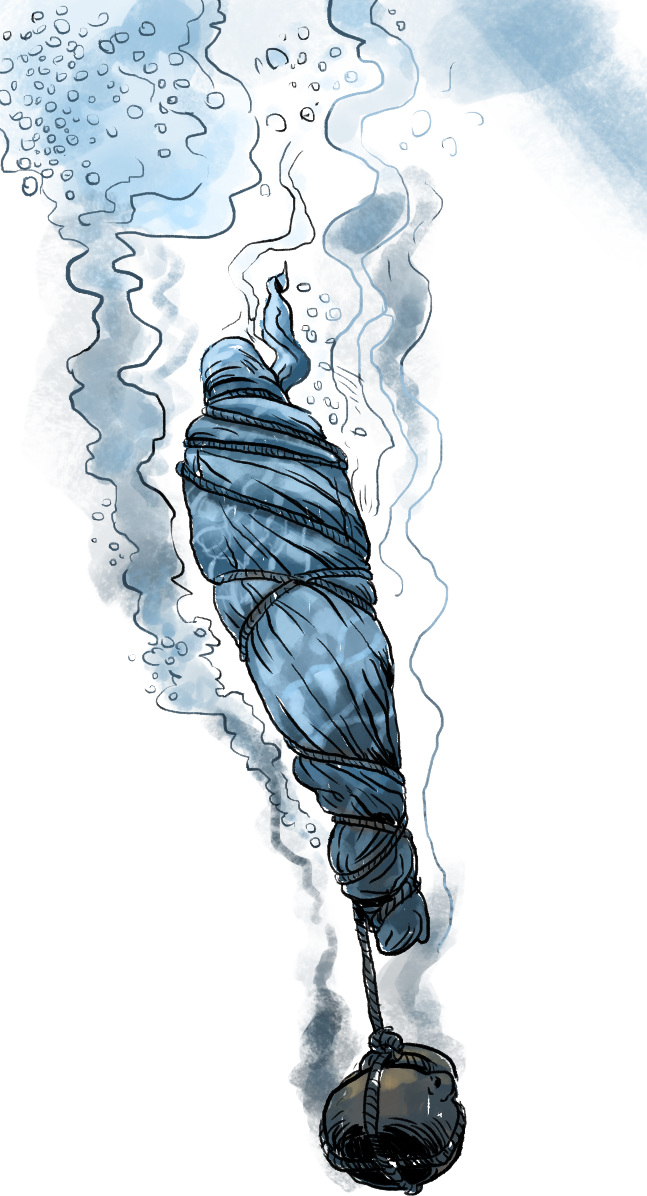
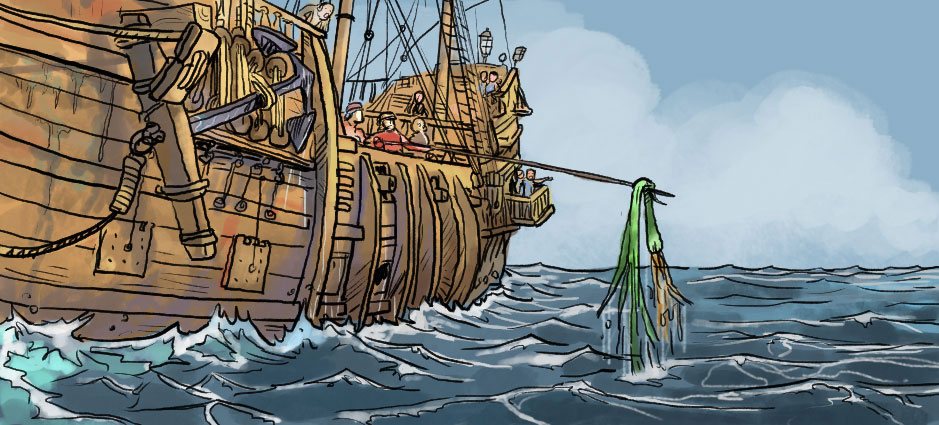
Three days later, a very long floating weed with onion-like roots, is sighted. The people onboard are filled with hope as they believe they must be close to land
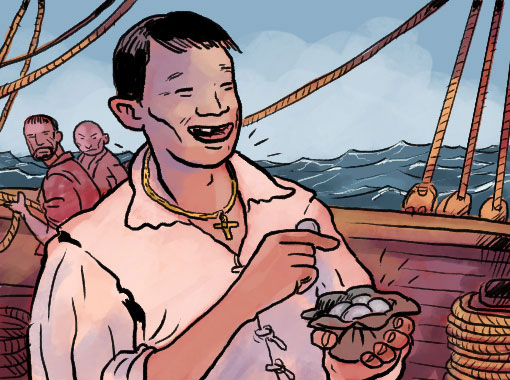
The sailor who spotted the weed is rewarded with a gold chain from the captain, and many of the passengers give him silver coins

Towards the evening of December 14, the island of Santa Catherine, near the coast of California, is sighted in the distance
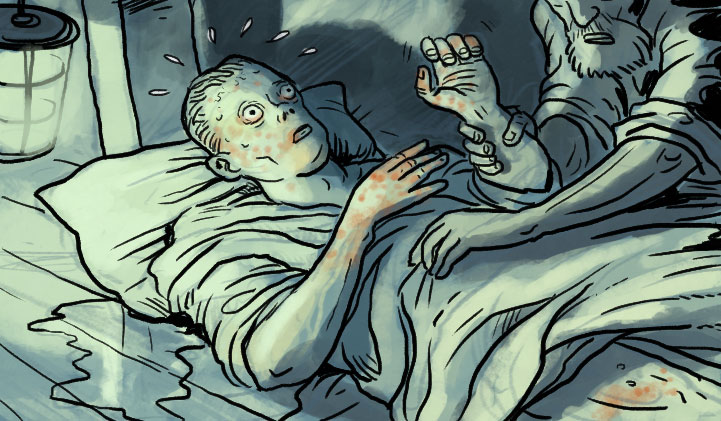
One of the two pilot’s mates dies and a few days later, the second captain dies of berben. There are two particularly dangerous diseases the sailors fear, one is berben*. This makes the body swell before damaging the brain, causing the patient to die in a state of delirium...
(*) Thiamine deficiency, also called beriberi
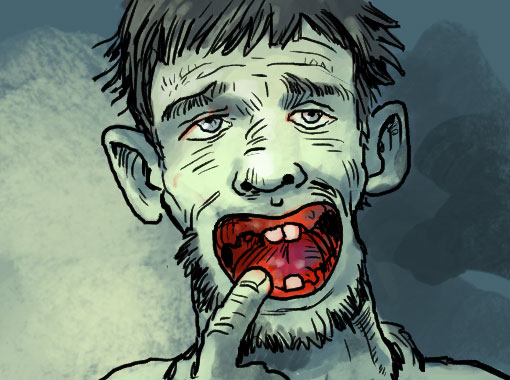
...the other is called the ‘Dutch disease’, or scurvy, which makes the mouth sore and putrefies the gums causing the teeth to fall out...

...and the skin to bleed
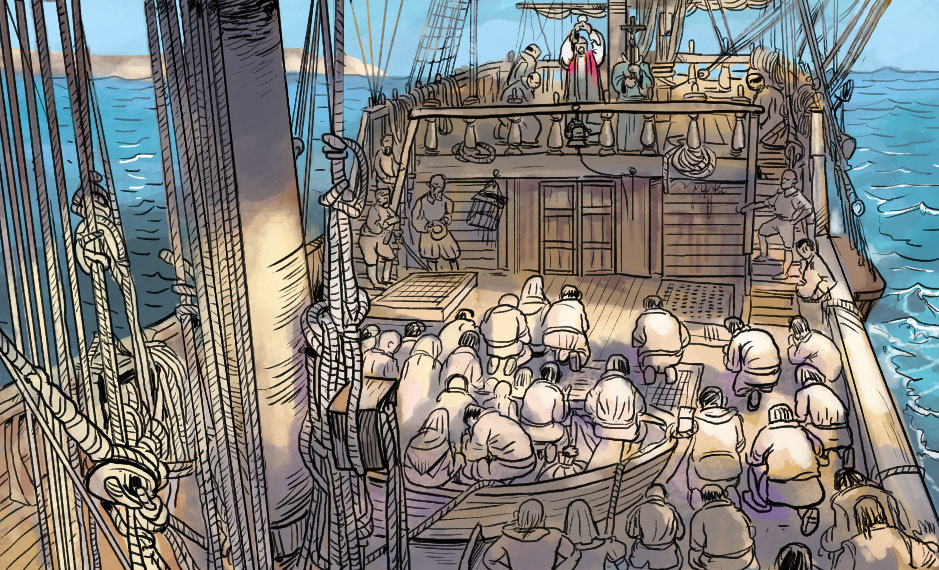
On Christmas Day they celebrate Mass within sight of Cape Saint Luke in Baja, California
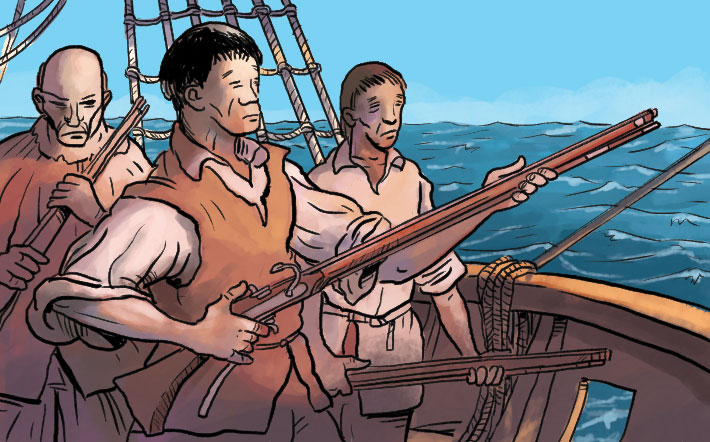
The next day, all onboard are given muskets to defend themselves against hostile enemies* often met off the coast of California
(*) English vessels and pirates often patrol the area in the hope of capturing galleons loaded with rich cargoes
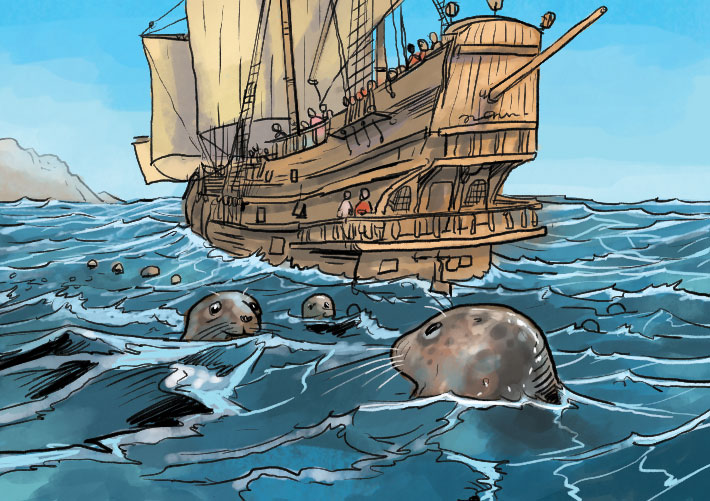
Seals bob up and down in the water. The Spaniards refer to them as lobillos de mar, or ‘little sea wolves’
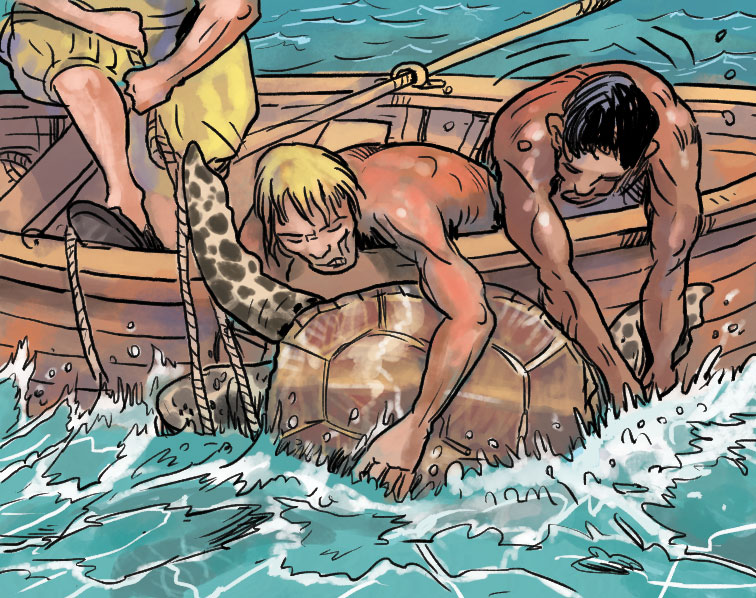
They send out the small boat and manage to catch seven turtles, relieving the hunger on board
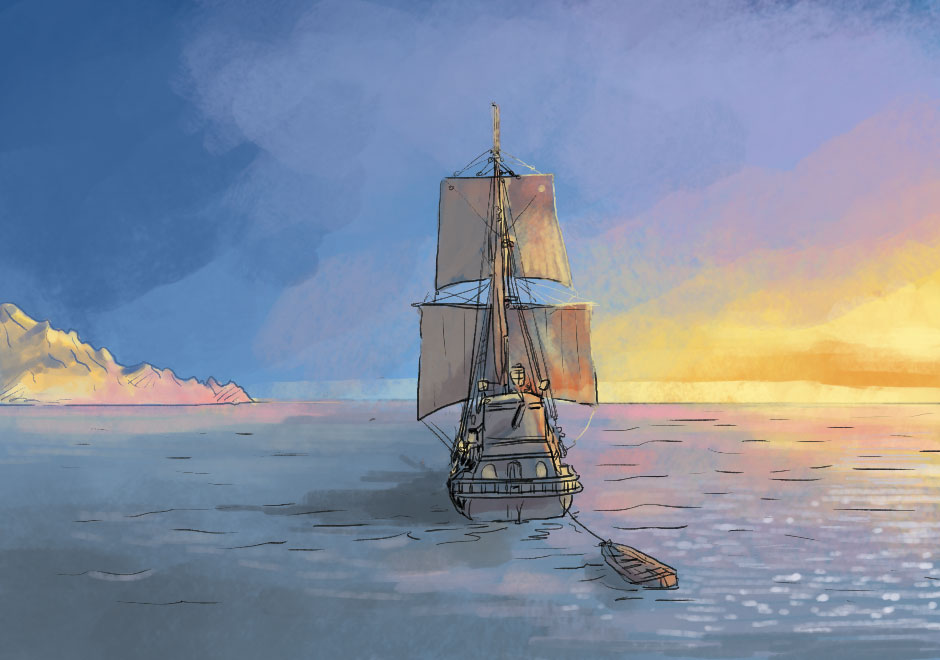










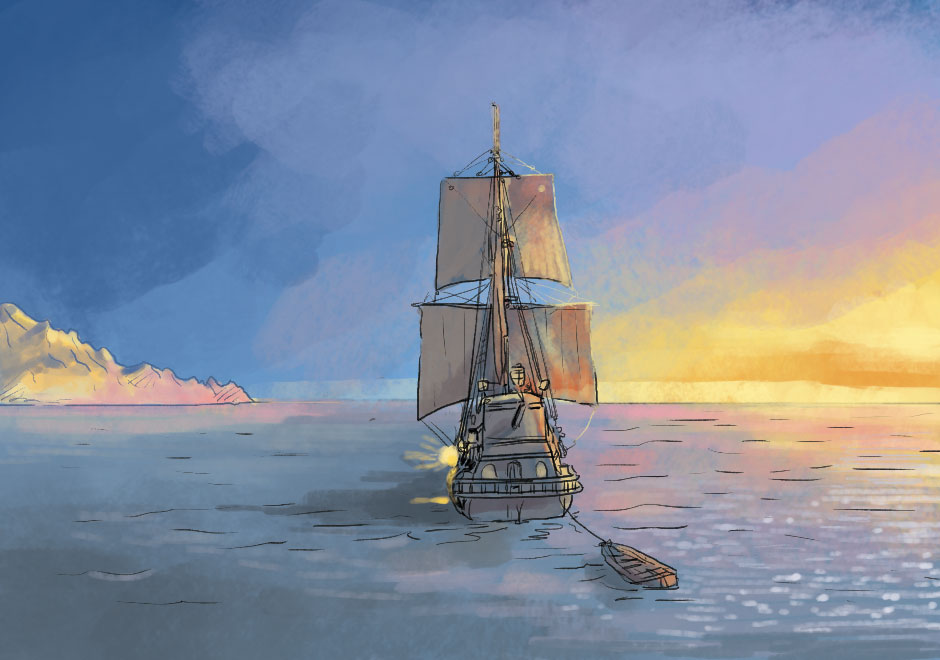
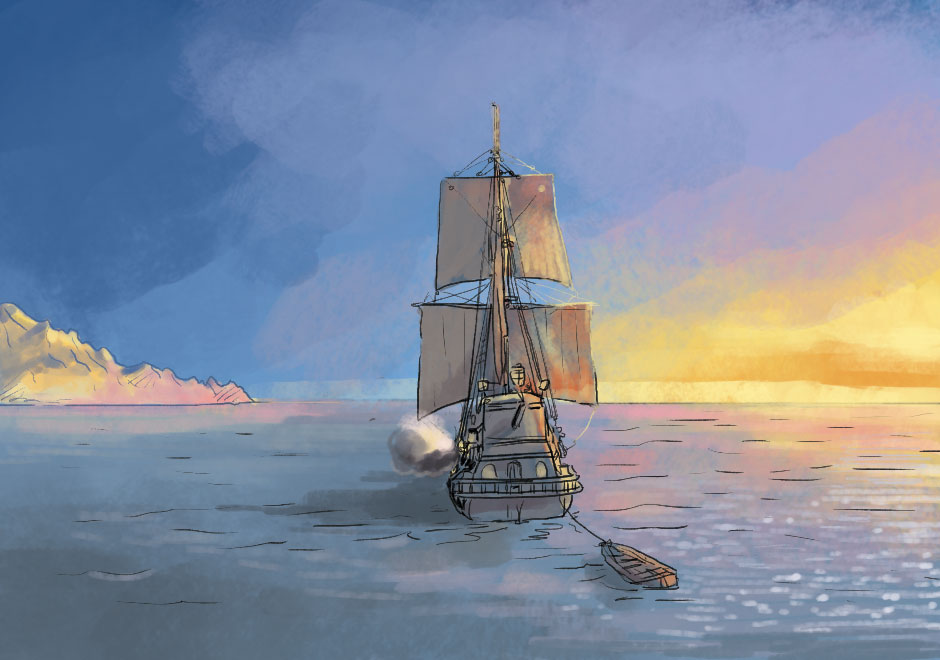
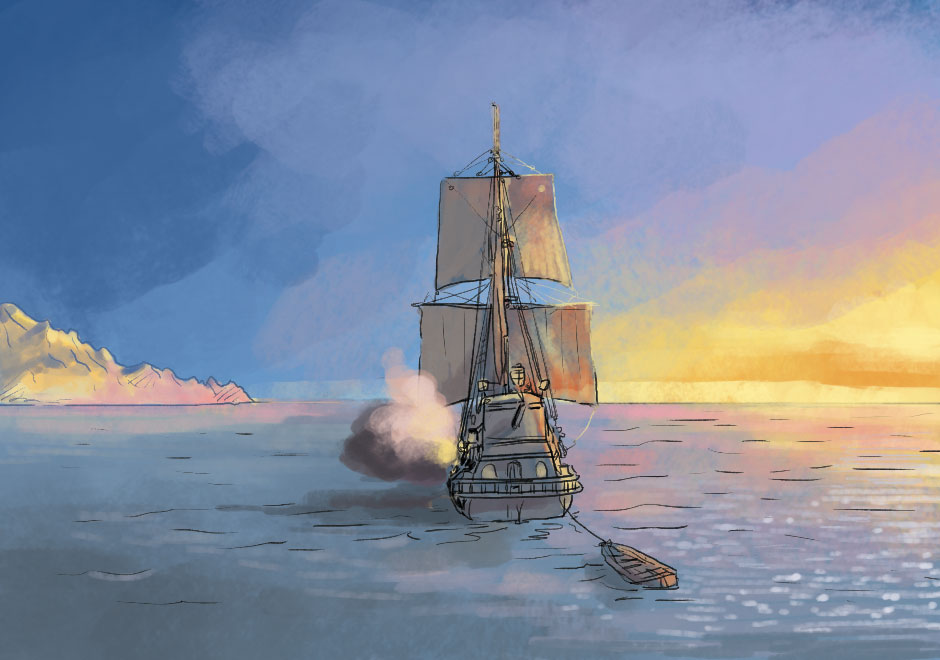
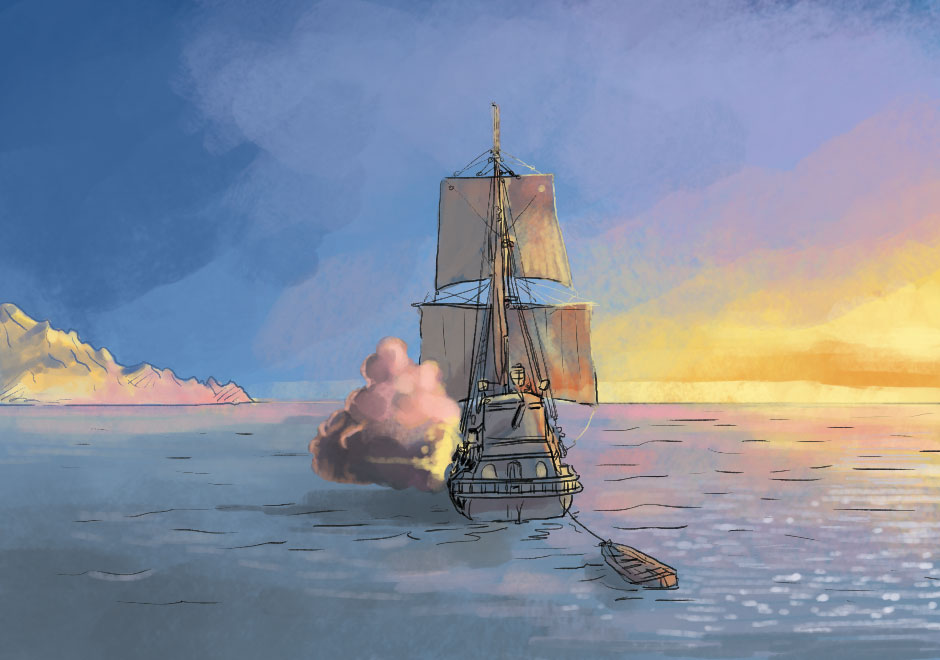
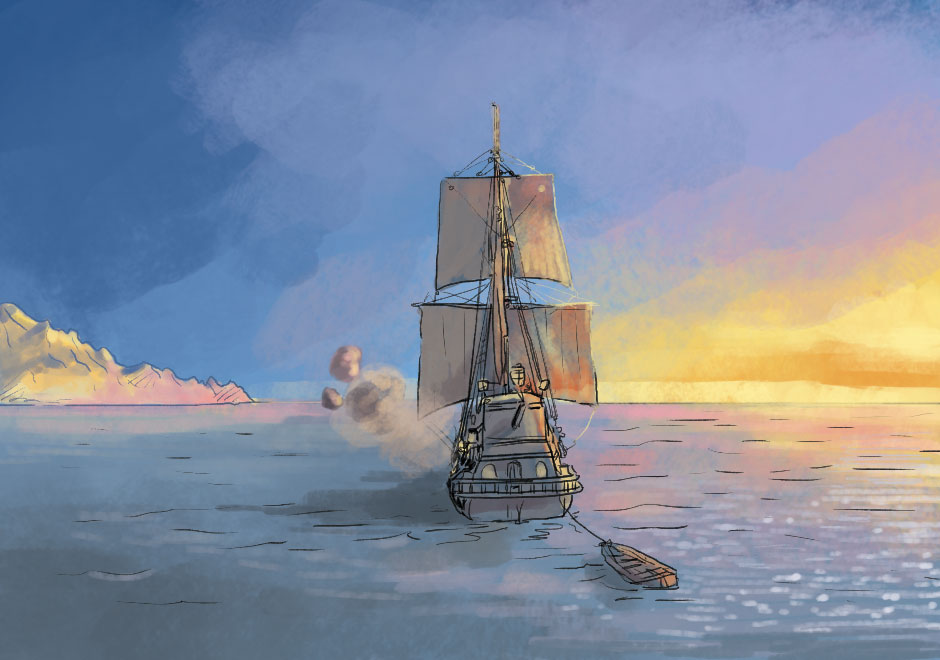
In the distance they can discern the outline of the coast. At sunset they announce their friendly arrival by firing cannons into the air. There is no response
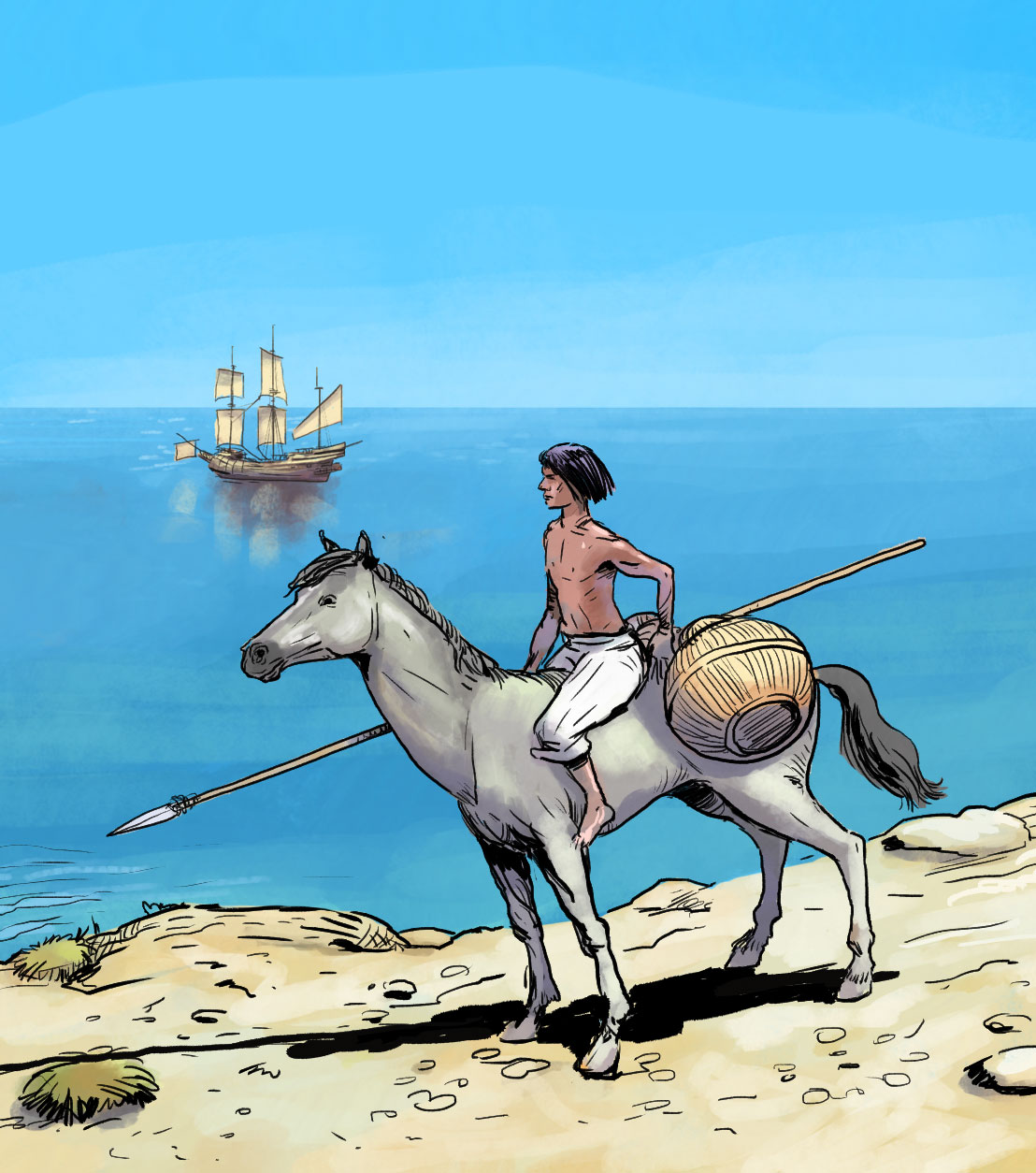
When the ship enters the torrid zone many onboard are adversely affected as the temperature suddenly soars. In turn, the sea becomes eerily calm and the galleon can barely move from the lack of wind
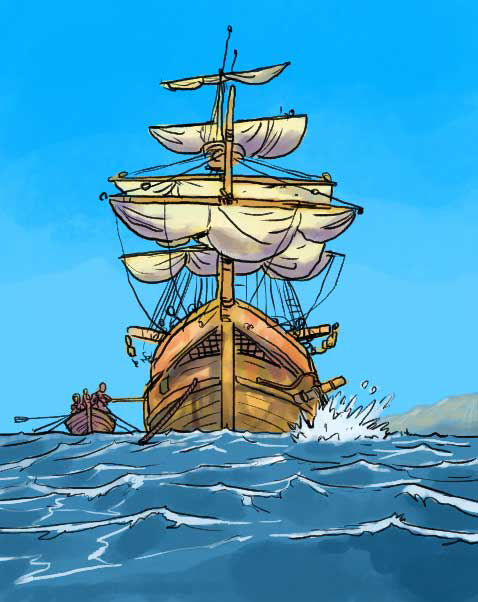
The anchors are dropped for the first time in months. This ship is about half a league from land. The small boat is launched in search of fresh water

Friday 18. The chief pilot’s life is in danger from scurvy, and berben, when they sight Acapulco Port
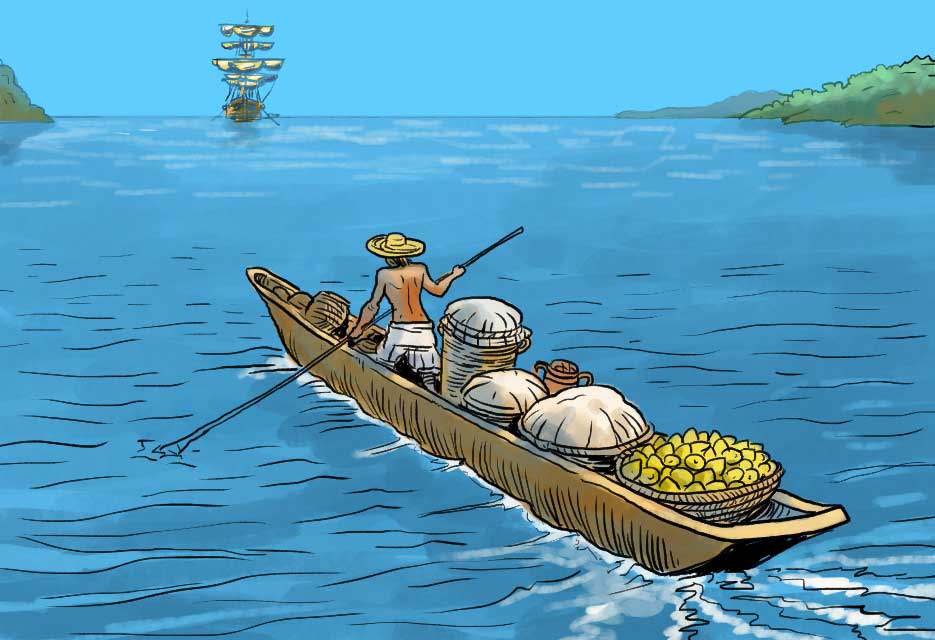
The travellers are delighted when a piragua delivers ox, fowl, bread and lemons to the galleon. The load seems to have been a gift from a certain Don Francis de Mecca, the mayor of a nearby coastal town
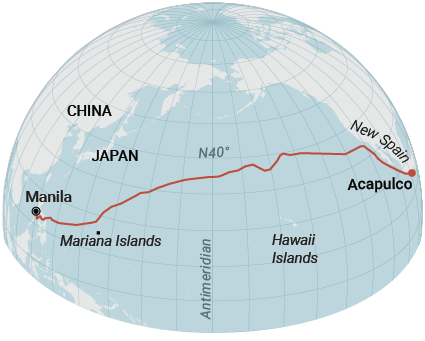
Around 9,000 miles sailed since leaving Manila
The survivors embrace in floods of joyful tears when they find themselves at their destination. The voyage has taken 204 days
A Te Deum is sung in thanksgiving, and the castle of Acapulco is given a seven-gun salute
In the last chapter of this special series, learn about how the dollar became a global currency and how the Chinese culture influenced Europe
ABOUT THIS GRAPHIC
Here are some of the awards that this graphic has obtained
Wanifra Asian Digital Media Awards
2018 Edition
Society For News Design
Edition 40
Here are some other digital native projects you might want to visit
Or just visit our graphics home page
This site has some features that may not be compatlibe with your browser. Should you wish to view content, switch browsers to either Google Chrome or Mozilla Firefox to get an awesome experience